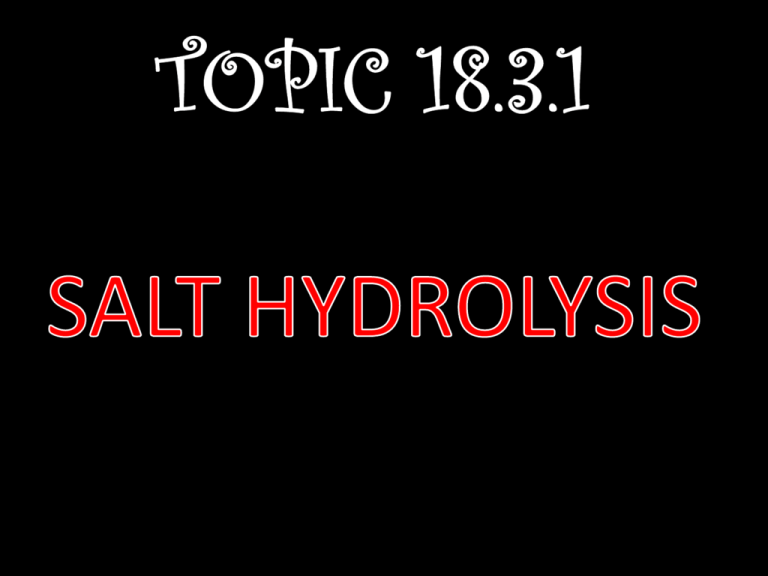Salt Hydrolysis
advertisement

•Assessment Statement: •Deduce whether salts form acidic, alkaline or neutral aqueous solutions. Let us reflect upon what we have learned. We learned of the Bronsted Lowry Theory and Lewis theories that enabled us to distinguish between acids and bases, we learned of pH and pOH, and so forth. We also learned that even ions have a particular Ka or Kb value which makes a solution acidic or basic. Assuming that all salts undergo complete dissociation in aqueous solution, we determine that all salts are strong ELECTROLYTES. (The word was on the scavenger hunt!) As a result of the dissociation, it is observed that the ions involved can cause water molecules to dissociate to form H+ and OH- ions. This process, of the dissociation of water molecules, is called HYDROLYSIS. * (Hydro- water; lysis- split!) The factor that enables the determination of the pH of an aqueous salt solution is the capability of the constituent ions to bring about the hydrolysis of water, and further react with the ions produced. This can be deduced using the table that helps us differentiate between strong and weak acids and bases, and the relative strengths of their conjugates. In a salt solution, remember the anion (negative ion) is the CONJUGATE BASE of an acid. Therefore, in adding a proton we can deduce the acid and its strength. This is generally of the order: X- + H+ HX Using this, recollect if the acid is a strong or weak one, and then deduce the strength of its conjugate base! (STRONG ACID Weak Conjugate Base Weak Acid STRONG CONJUGATE BASE) A weak conjugate base will have negligible tendency to cause the hydrolysis of water, thus limiting the production of OH- ions in solution. There is consequently NO EFFECT on the pH of the solution. However, a stronger conjugate base will have comparatively larger tendencies of evoking the hydrolysis of water. The H+ ions will react with the anion in solution, leaving behind OH- ions. This causes the pH to rise, making the solution ALKALINE. The theory discussed previously applies only to anions that have completely dissociated and cannot release any more H+ ions in solution. However another kind of salt exists. These are the kind whose anion is capable of releasing more H+ ions in solution. These kind of anions are called AMPHIPROTIC. The values of Ka and Kb will determine their behavior in water. If Ka > Kb, the solution will be ACIDIC, however if Ka < Kb the solution will be ALKALINE. As observed with anions, cations (positive ions) also determine the pH of a salt solution. Can you tell how? (Yes here’s the answer: STRONGER CONJUGATE ACIDS donate a proton to water to form a HYDRONIUM ion, making it ACIDIC! Weaker conjugate acids have a lower tendency to do so. Thus, not affecting the pH to a large extent.) Now consider Metal Ions… Metal ions, being positive, attract the unshared electron pairs on water molecules. The interaction, called HYDRATION, causes salts to dissolve in water. If we think about this in terms of the Lewis theory, we realize that as the electrons on the Oxygen atom in water get attracted to the positive metal ion, the bond between the hydrogen and oxygen gets more polarized. Thus, water molecules bonded to the metal ion are more acidic than the rest of the molecules in solution. EXAMPLES: 1.) sodium ethanoate solution sodium ethanoate is 100% dissociated into ions:CH3COONa CH3COO- + Na+ Sodium ions are from a strong base (sodium hydroxide) and do not interact with the water ions. However, the ethanoate ions do interact with the hydrogen ions from the water equilibrium (H2O H+ + OH-) CH3COO- + H+ CH3COOH We know that this last equilibrium lies to the side of the ethanoic acid (to the right), removing the hydrogen ions from the solution. As [H+] decreases the pH rises. Hence a solution of sodium ethanoate has a pH greater than 7. We say that it is basic by hydrolysis. 2.) Ammonium chloride solution Ammonium chloride dissociates 100% into ions in solution NH4Cl NH4+ + ClThe ammonium ions interact with the hydroxide ions from the water removing them from the solution (equilibrium lies to the right) NH4+ + OH- NH3 + H2O This increases the concentration of hydrogen ions (as [H+] x [OH-] is constant) increasing the acidity of the solution (decrease pH) We say that a solution of ammonium chloride is acidic by hydrolysis. General rules • When the negative ion is from a weak acid then the salt is basic by hydrolysis • When the positive ion is from a weak base then the salt is acidic by hydrolysis • If the salt is formed from a strong acid and strong base then it is neutral • If the salt is formed from a weak acid and weak base then its hydrolysis is determined by the relative Ka and Kb values Charge density This means the charge to size ratio of the ion. charge density = ionic charge/ionic size When the ion has a charge of 3+ or when it is very small this charge to size ratio is enough to polarise the water molecules surrounding the ion in solution. This results in a weakening of the O-H bonds within the water molecules allowing hydrogen ions to be released into the solution. Hence the solutions are acidic. This effect is typified in aluminum salts (the aluminum ion has a charge of 3+) which are very acidic in solution EXAMPLE: The aluminum hexa-aqua ion Aluminum ions are surrounded by six water molecules in an octahedral arrangement. This is called the aluminum hexa-aqua ion. The high charge density of the aluminum ion polarises the water molecules and hydrogen ions are released into solution. The solution is so acidic that it releases carbon dioxide from sodium carbonate (this reaction is used in some fire extinguishers to produce foam in conjunction with detergent) [Al(H2O)6]3+ [Al(OH)(H2O)5]2+ + H+ [Al(OH)(H2O)5]2+ [Al(OH)2(H2O)4]+ + H+ Transition metals As the transition metals have variable oxidation states the ions that are formed with high charges (high oxidation state) also produce acidic solutions. A good example of this is the Iron III ion. Salts such as iron III sulphate are acidic in solution. [Fe(H2O)6]3+ [Fe(OH)(H2O)5]2+ + H+






